Overview:
Creating a diabetic diet PDF involves understanding key dietary elements such as carbohydrate control, glycemic index, portion control, and balanced meals to effectively manage blood sugar levels. The article outlines a structured approach to develop this PDF, emphasizing the importance of gathering reliable information, selecting a suitable template, and incorporating meal planning strategies, which collectively enhance diabetes management and nutritional adherence.
Introduction
Managing diabetes effectively requires a comprehensive understanding of dietary choices and their impact on blood sugar levels. A diabetic diet is not merely a set of restrictions; it is a structured approach to nutrition that emphasizes balance, portion control, and informed decision-making. By focusing on critical components such as:
- Carbohydrate management
- The glycemic index
- Meal planning strategies
individuals can create a personalized diet that supports their health goals. This article delves into the essential elements of a diabetic diet, offering practical guidance on:
- Crafting meal plans
- Monitoring blood sugar levels
- Utilizing resources that enhance diabetes management
As the prevalence of diabetes continues to rise, equipping oneself with knowledge and tools is more crucial than ever for maintaining a healthy lifestyle.
Understanding the Basics of a Diabetic Diet
A diabetic diet PDF is essential for managing blood sugar levels while ensuring optimal nutrition. The subsequent essential elements are crucial for effective control of blood sugar levels:
-
Carbohydrate Control: It is vital to understand how carbohydrates influence blood sugar. Strive for a consistent intake of carbohydrates at each meal to maintain stable glycemic levels. Studies show that carbohydrate control is essential in preventing the occurrence of the condition, as emphasized by Meyer et al., who investigated the association between dietary fiber and its impacts on older women with type 2 diabetes. Additionally, managing carbohydrate intake is particularly important for individuals on insulin therapy, as the mean daily basal insulin is 33.8 IU (SD 21.3).
-
Glycemic Index: Foods with a low glycemic index (GI) are highly recommended, as they cause a slower rise in blood sugar levels. Examples of low-GI foods include whole grains, legumes, and various fruits and vegetables. Recent findings indicate that a moderate carbohydrate eating plan yielded a higher total score on the Diabetes Treatment Satisfaction Questionnaire (DTSQs), averaging 28.7 (SD 5.4) compared to 27.4 (SD 6.1) for traditional eating patterns, demonstrating a significant difference (p = 0.026). This implies that individuals might experience greater contentment and control over their condition when adhering to a meal plan that highlights low-GI foods. As Andrew Martin mentions, 'Comprehending the influence of nutrition on blood sugar conditions is essential for effective control.'
-
Portion Control: Mindfulness regarding portion sizes is essential to avoid blood sugar spikes. Utilizing measuring cups or a food scale can assist in precisely assessing portions, ensuring balanced intake and improved glycemic management.
-
Balanced Dishes: A well-rounded dish should include a variety of food groups, such as proteins, healthy fats, and fiber-rich carbohydrates, which support overall health and increase satiety.
By comprehending these essential elements, individuals can take initial steps toward developing a personalized diabetic diet PDF that addresses their specific nutritional needs and lifestyle requirements. For extra assistance and resources on meal planning and blood sugar control, visit T2DSolutions, your all-inclusive center for Type 2 and Type 3 blood sugar education.
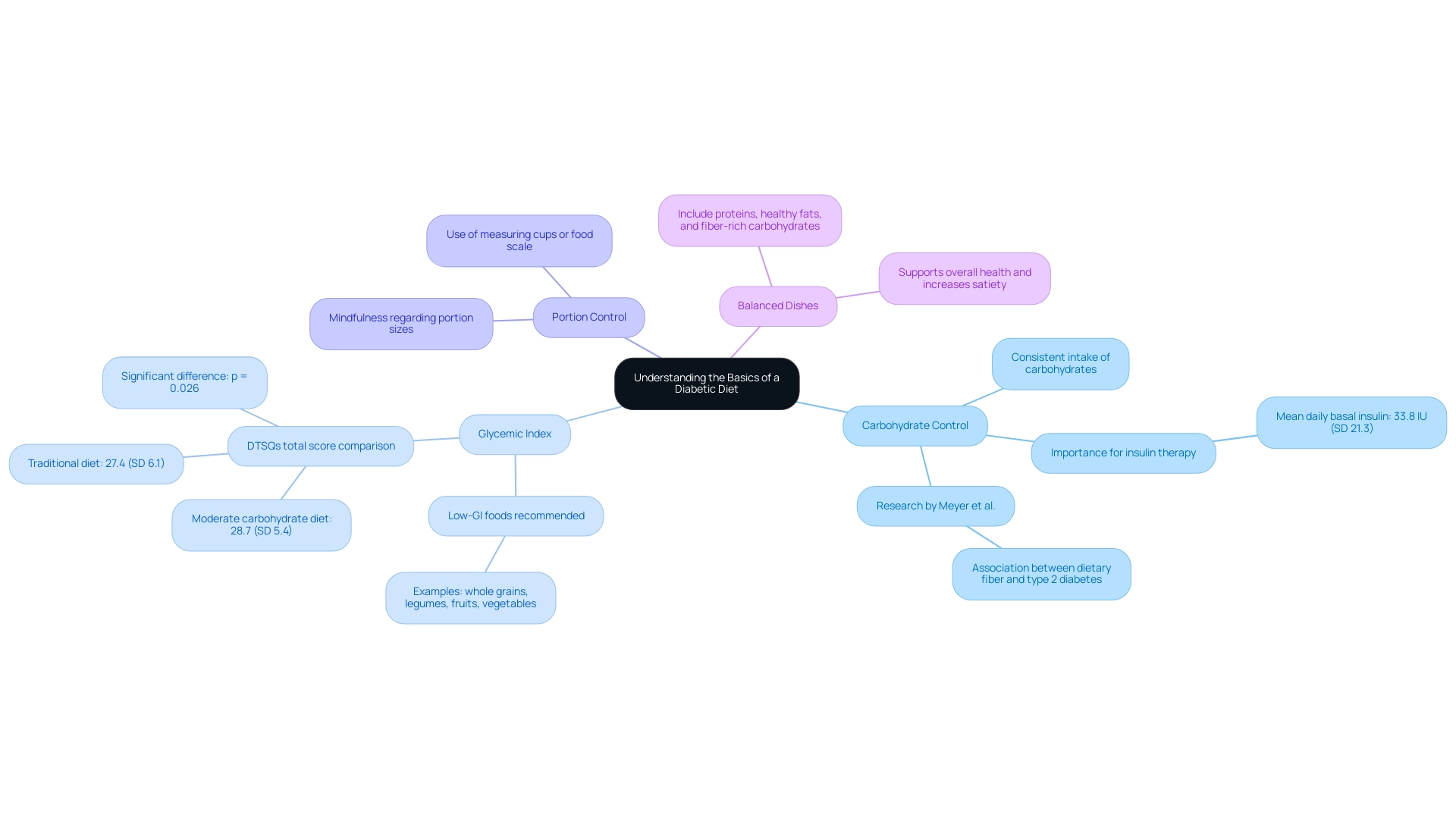
Step-by-Step Guide to Creating Your Diabetic Diet PDF
To create an effective diabetic diet PDF, follow this structured approach:
-
Gather Information: Begin by compiling dietary guidelines from authoritative sources, such as the American Diabetes Association (ADA). This should encompass critical information on carbohydrate counting, appropriate portion sizes, and optimal food choices for diabetes management. Notably, current dietary fiber consumption in the United States is approximately 16g per day, emphasizing the importance of incorporating fiber-rich foods into your meals.
-
Select a Template: Choose a PDF template that facilitates easy input and organization of your dietary information. Numerous online platforms provide customizable templates specifically designed for dietary planning.
-
Outline Your Meal Plan: Organize your meal plan into clearly defined sections for breakfast, lunch, dinner, and snacks. For each dish, specify recommended foods and their corresponding portion sizes, adhering to the latest guidelines. According to the ADA, "table sugar and other sugars in your meals don't raise blood glucose levels any higher than other simple carbohydrates," which can help guide your choices.
-
Include Recipes: Enrich your PDF with healthy recipes that cater to your dietary requirements. Ensure these recipes are straightforward to prepare and include detailed nutritional information to facilitate informed choices.
-
Review and Edit: Carefully review your document to confirm clarity and completeness. Make necessary adjustments to align the content with your personal preferences and dietary needs. Keep in mind, as emphasized in the case study regarding the timing of insulin and food, personalized dietary planning is essential to avoid hypoglycemia and ensure effective control of blood sugar levels.
-
Save and Print: Once your document is finalized, save it as a PDF and print multiple copies for convenient reference.
By following this comprehensive approach, you will create a user-friendly diabetic diet PDF that supports effective diabetes management and aligns with current dietary recommendations.
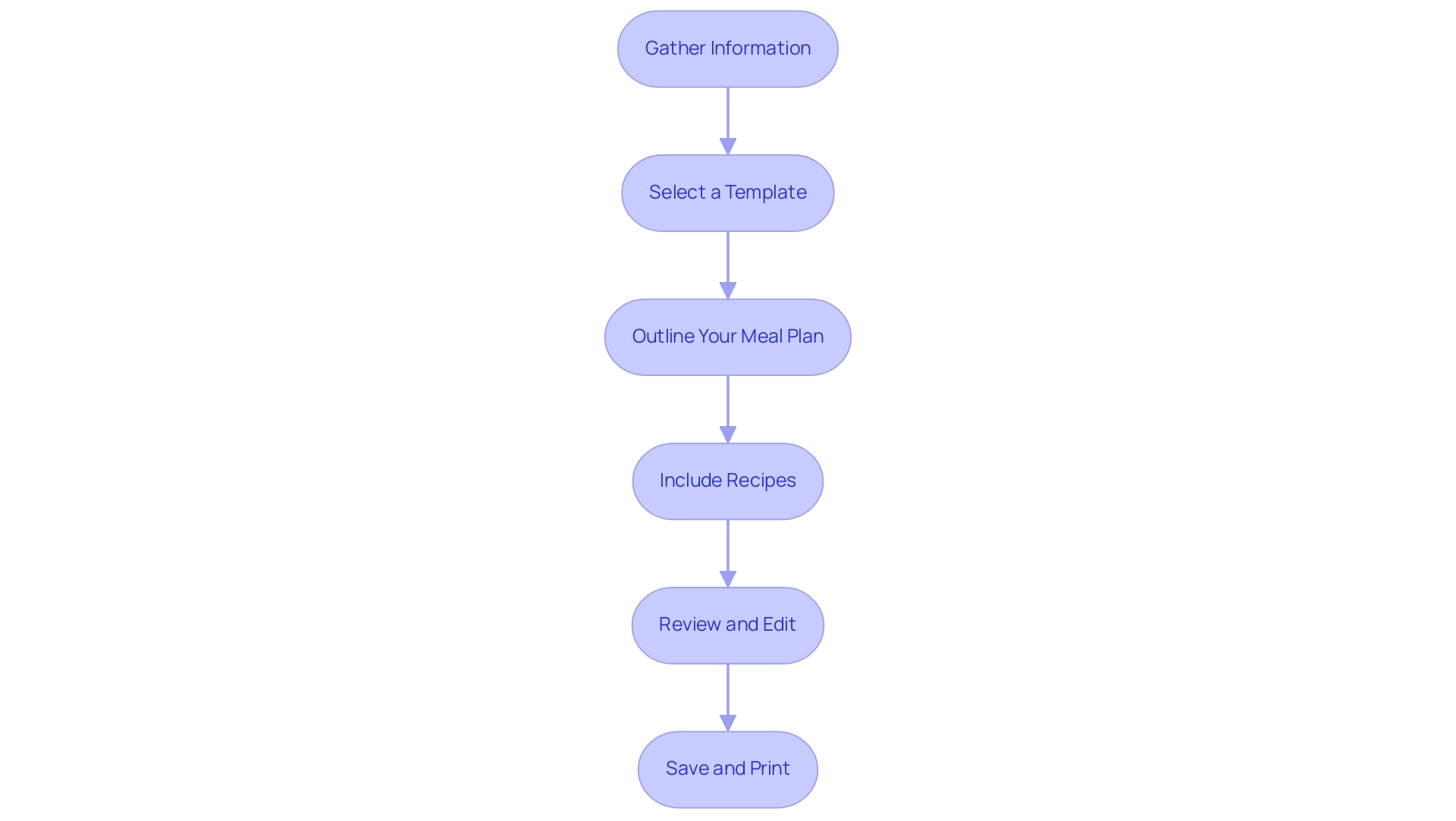
Meal Planning Strategies for Diabetic Diets
To effectively support your diabetic diet, implement the following food planning strategies:
- Plan Ahead: Allocate time each week to thoughtfully arrange your dishes and snacks. This proactive approach reduces the likelihood of impulsive eating, which can lead to fluctuations in blood sugar levels.
- Use a Food Planner: Consider utilizing a planning template or a dedicated app to organize your dishes for the week. Including grocery lists can further streamline your shopping experience, ensuring you have the necessary ingredients on hand.
- Incorporate Variety: It is crucial to diversify your dishes to encompass a broad range of nutrients. Experiment with various vegetables, proteins, and whole grains to keep your dishes engaging and nutritionally balanced. Understanding the nutritional profiles of protein foods, such as fish, chicken, meats, soy products, and cheese, can aid in making healthier choices. While some options are higher in fat and calories, identifying lean alternatives is essential. For instance, focusing on lean cuts of meat and low-fat dairy can help manage overall calorie intake.
- Carbohydrate Management: Aim to reduce carbohydrate intake to less than 26% of your total calories, targeting a goal of 20–50 of non-fiber carbohydrates per day. This diabetic diet pdf can assist you in better managing blood sugar levels through dietary planning.
- Portion Control: Employ measuring tools to ensure appropriate portion sizes, particularly regarding carbohydrates. This practice is crucial for efficient oversight of blood sugar levels.
- Prepare Dishes in Batches: Cooking larger portions of healthy dishes and dividing them into individual containers can provide easy access to nutritious options throughout the week.
Additionally, it is important to collaborate closely with your healthcare provider and nutritionist to create a suitable eating plan, as not following it can lead to fluctuating blood sugar levels and serious complications.
By adhering to these strategies, you will not only maintain a balanced nutrition but also effectively oversee your condition, leading to a healthier and more fulfilling life. As Linda Clark, NP, states,
By embracing the benefits of food preparation and utilizing the knowledge of healthcare experts, you can simplify the challenges of blood sugar control and focus on living well.
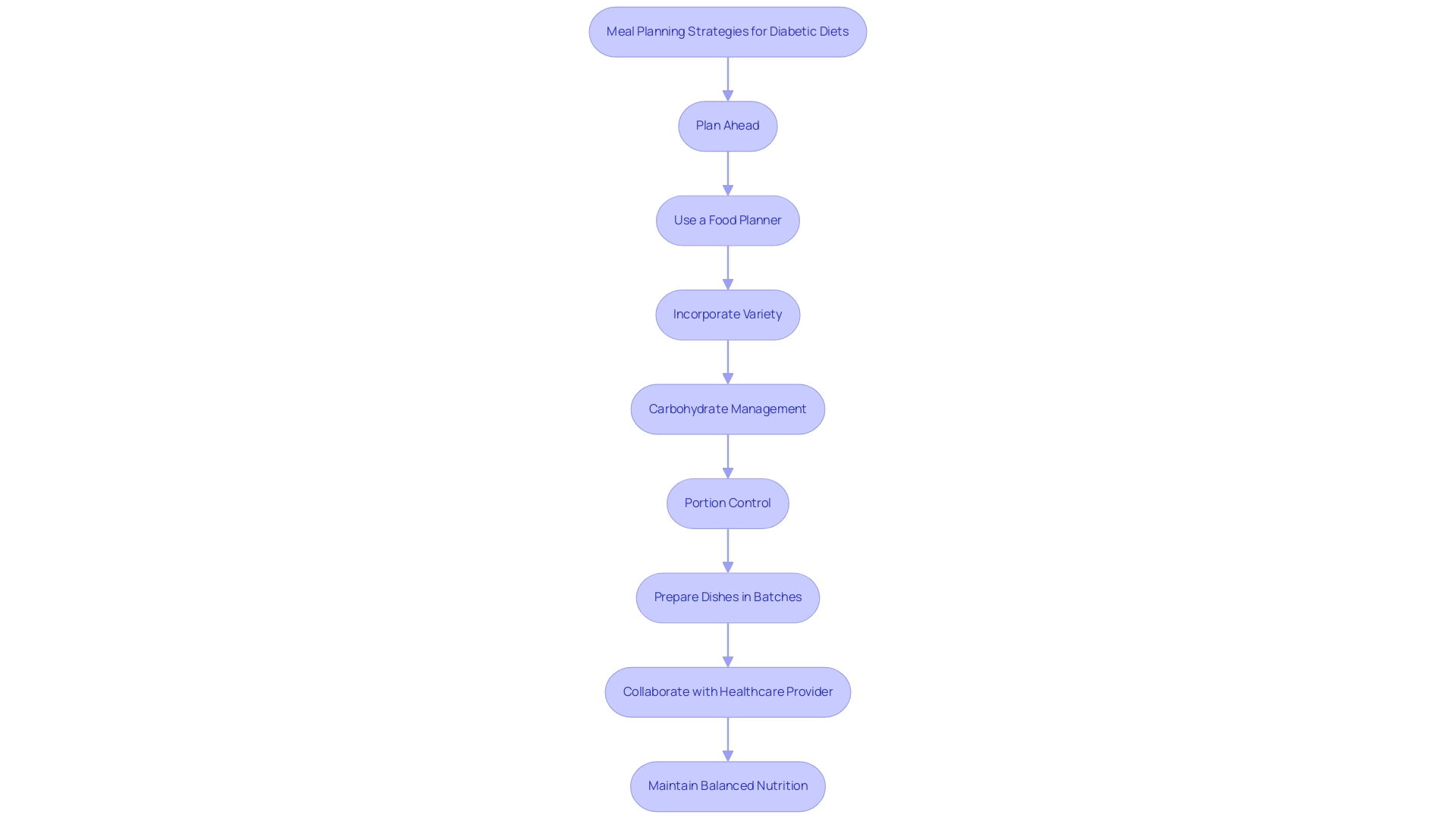
Monitoring and Adjusting Your Diabetic Diet
As part of T2DSolutions, your comprehensive resource for Type 2 and Type 3 blood sugar control, we emphasize the following essential practices to effectively handle your diabetic diet pdf. T2DSolutions is a new site that is just getting started, and you can subscribe to stay updated on new content and resources.
- Regularly Check Blood Sugar Levels: Utilize a glucose meter to monitor your blood sugar before and after meals. This data is vital for understanding how various foods influence your blood sugar levels.
Significantly, statistics show that 31.9% of U.S. adults with diagnosed blood sugar issues are physically inactive, highlighting the importance of regular monitoring and physical activity in controlling the condition. Engaging in at least 150 minutes of moderate aerobic activity each week can significantly improve blood sugar control, and referring to a diabetic diet pdf can assist in maintaining a detailed record of your food intake alongside blood sugar readings. This method not only aids in recognizing patterns but also helps identify potential food sensitivities.
As per healthcare experts, food journals are useful instruments for controlling blood sugar, especially when utilizing a diabetic diet pdf, as they provide understanding of how nutrition directly influences glucose levels. Lead author I.B.H. reviewed all content and is the guarantor of this work, emphasizing the importance of tracking dietary habits.
- Adjust Based on Readings: If certain foods consistently elevate your blood sugar, consider minimizing or eliminating them from your diet.
It is advisable to consult with a healthcare provider to receive tailored recommendations based on your individual readings. For example, Hispanic individuals constitute a considerable demographic, with 5.0 million diagnosed instances of high blood sugar, emphasizing the necessity for culturally relevant dietary modifications.
- Stay Informed: Engage in education classes or workshops to gain insight into the latest dietary strategies and oversight techniques. Expert insights emphasize the importance of ongoing education in adjusting to shifts in health care. Furthermore, awareness of the increased occurrence of diagnosed conditions among adults residing in nonmetropolitan regions can assist in customizing support and resources for those communities.
By following these practices and using T2DSolutions as your primary resource, which will consistently offer updated information and assistance, you will be prepared to make informed choices regarding your diabetic diet pdf, which will facilitate effective control of your health.
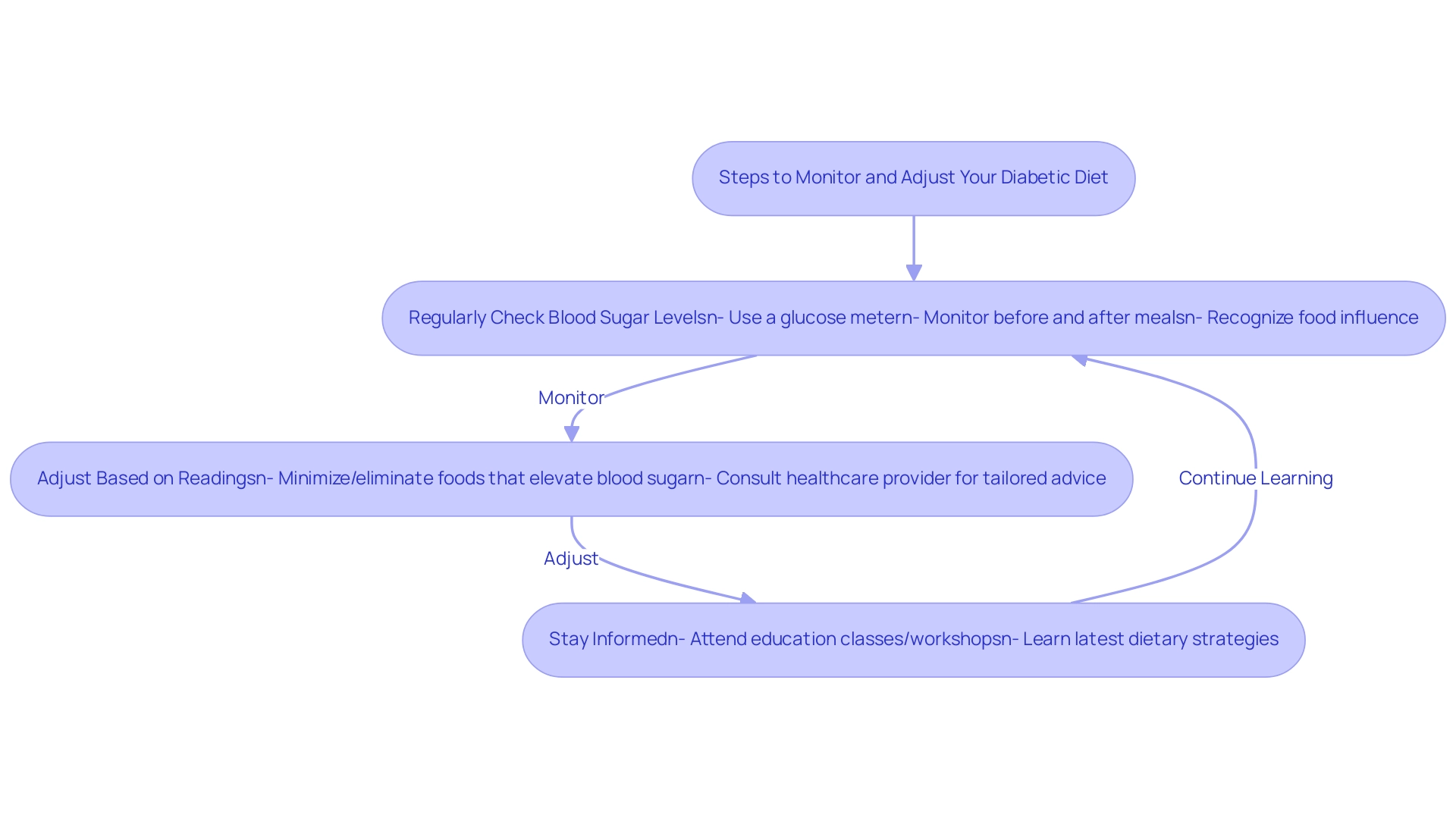
Resources and Tools for Effective Diabetes Management
Welcome to T2DSolutions, your new resource hub for Type 2 and Type 3 health education and community support, currently in development. To assist your journey in handling your condition effectively, consider utilizing the following resources and tools, now available through T2DSolutions:
-
Health Education Programs: Seek out local or online classes that deliver comprehensive information about managing the illness. Programs like these have been shown to improve patient outcomes, with studies indicating that structured education can significantly enhance self-management skills. According to Ricci-Cabello and colleagues, there are no statistically significant differences in the effectiveness of various program durations or intensities, suggesting that consistent engagement is key. A case study by Surucu et al. (2017) involving adults with Type 2 Diabetes Mellitus indicated a 56.12% outcome response rate after just three sessions on unclear topics, highlighting the potential of structured education interventions.
-
Nutrition Apps: Leverage technology by using popular apps such as MyFitnessPal or Carb Manager to meticulously track food intake and monitor carbohydrate consumption. These tools have gained recognition for their user-friendly interfaces and effectiveness in reinforcing dietary choices. In fact, many patients find that regular use of these apps leads to greater awareness of their eating habits and improved management of their diabetes.
-
Cookbooks: Invest in diabetic-friendly cookbooks that provide recipes tailored to your nutritional requirements. These cookbooks can provide practical, tasty dining choices that correspond with a health-conscious diet, including options from a diabetic diet pdf, making it easier to adopt healthier eating habits at home.
-
Support Groups: Engage with support groups for those managing blood sugar, whether in-person or online. Connecting with others who share similar experiences can provide emotional support and practical advice. Taking part in such groups has been demonstrated to improve motivation and compliance with dietary recommendations.
-
Professional Guidance: Consult a registered dietitian or nutrition educator for personalized dietary advice and meal planning assistance. Their expertise can assist in customizing suggestions to your specific requirements, guaranteeing that you obtain the most effective strategies for managing your condition.
Considering the anticipated worldwide economic impact of this illness from 2015 to 2030, utilizing these resources is essential. They not only enhance your understanding of diabetes management but also empower you to maintain an effective diabetic diet, ultimately leading to better health outcomes. Don't forget to subscribe to stay updated on new content and resources as T2DSolutions continues to grow!
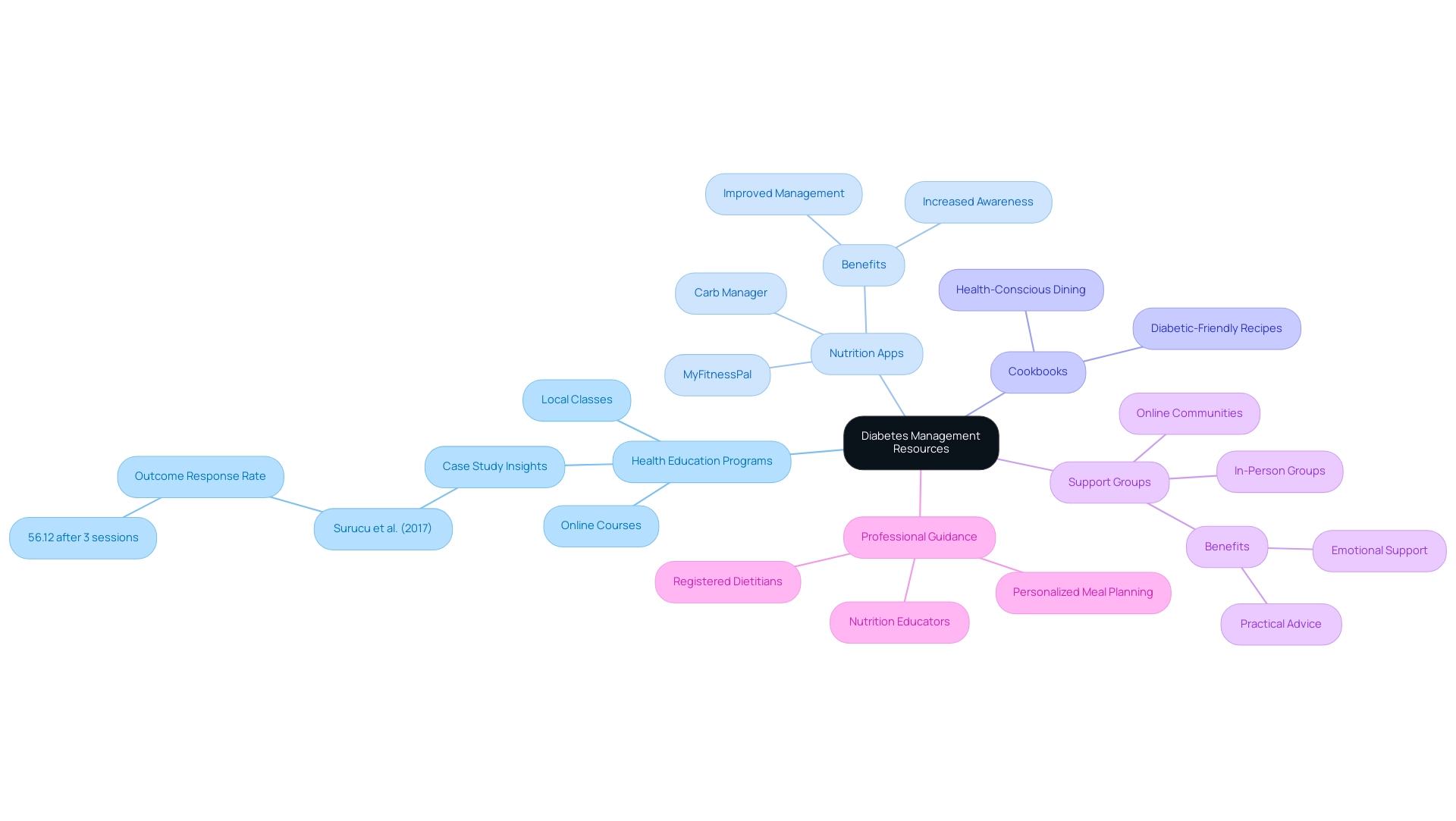
Conclusion
Managing diabetes effectively hinges on a solid understanding of dietary choices and their influence on blood sugar levels. A diabetic diet is not merely about restrictions but rather about creating a balanced nutritional framework that incorporates:
- Carbohydrate management
- The glycemic index
- Portion control
By implementing meal planning strategies and utilizing available resources, individuals can craft personalized diets that align with their health goals.
The key components discussed—monitoring blood sugar levels, incorporating low-GI foods, and practicing portion control—serve as foundational pillars for achieving effective diabetes management. Additionally, the importance of education and continuous learning in adapting dietary choices cannot be overstated. By engaging with resources like:
- Diabetes education programs
- Nutrition apps
- Professional guidance
Individuals can gain the insights necessary to make informed dietary decisions.
Ultimately, the journey toward managing diabetes is one of empowerment. By understanding and applying the principles outlined, individuals can take proactive steps toward a healthier lifestyle, reducing the risk of complications and enhancing overall well-being. Embracing these strategies not only fosters better health but also equips individuals with the tools needed to navigate the complexities of diabetes management with confidence.



